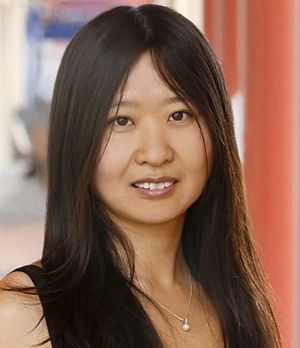Doris Tsao facts for kids
Quick facts for kids
Doris Tsao
|
|
|---|---|
 |
|
| Born |
Changzhou, China
|
| Citizenship | American |
| Alma mater | California Institute of Technology (BS) Harvard University (PhD) |
| Known for | Face perception |
| Awards |
|
| Scientific career | |
| Fields | Neuroscience Visual perception |
| Institutions | University of California, Berkeley |
| Thesis | Stereopsis (2002) |
| Doctoral advisor | Margaret Livingstone |
Doris Ying Tsao is an American scientist who studies the brain. She is a professor of neurobiology at the University of California, Berkeley. Before this, she taught at the California Institute of Technology for 12 years.
Professor Tsao is known for her groundbreaking work in understanding how our brains recognize faces. She was one of the first to combine special brain scans called fMRI with detailed recordings of brain cells. This helped her discover the "face patch system" in macaque monkeys, which are specific areas in the brain that light up when faces are seen.
She is also an investigator at the Howard Hughes Medical Institute and leads the T&C Chen Center for Systems Neuroscience. In 2018, she received a special award called the MacArthur "Genius" fellowship. In 2020, she became a member of the National Academy of Sciences. In 2024, she won the Kavli Prize in neuroscience, along with Nancy Kanwisher and Winrich Freiwald, for their discoveries about how the brain recognizes faces. She also received the Rosenstiel Award in 2024.
Since joining UC Berkeley in 2021, her research focuses on how primates (like monkeys and humans) see the world. She wants to understand how our brains create what we think of as reality.
Early Life and Education
Doris Tsao was born in Changzhou, China. When she was four years old, her family moved to the United States. She grew up in College Park, Maryland, and went to Springbrook High School.
She became interested in science, especially how we see things, after reading about famous scientists and philosophers. She studied biology and mathematics at Caltech, finishing her bachelor's degree in just three years in 1996.
After Caltech, she worked with Margaret Livingstone at Harvard Medical School. She earned her PhD in neuroscience in 2002 and continued her research there. In 2004, she received the Sofia Kovalevskaya Award. This award allowed her to start her own research group in Germany from 2004 to 2008. In 2009, she returned to Caltech as a biology professor. She also became a leader at the Tianqiao and Chrissy Chen Center for Systems Neuroscience.
Career and Brain Research
As a student, Doris Tsao began by studying how monkeys see depth, a process called stereopsis. She used a method that recorded the activity of single brain cells. Later, she became interested in using fMRI, a brain scanning technique often used to see brain activity in humans.
She worked with other scientists to use fMRI to study brain regions in monkeys. She teamed up with Winrich Freiwald to combine fMRI with single-cell recordings. This allowed them to study how monkeys recognize faces. They found small brain areas in monkeys, similar to the fusiform face area in humans, that are specifically active when faces are seen. These areas are called the macaque "face patch system."
Professor Tsao and her team have made big discoveries about what specific features of faces make these brain cells react. In 2017, her lab made a breakthrough. They figured out how our brains "code" or understand faces. They identified the exact features that make face-selective neurons in the brain respond. This meant they could even reconstruct images of faces just by looking at the brain cell activity!
In 2007, Doris Tsao was recognized on MIT Technology Review's TR35 list, which highlights top innovators under 35. She also serves on an important committee that advises on how to spend money for neuroscience research, helping to guide over a billion dollars in funding.
See Also
- List of neuroscientists
- Margaret Livingstone
- Science (journal)
- MacArthur Fellows Program

